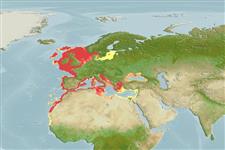Environment: milieu / climate zone / depth range / distribution range
Ecology
Marine; demersal; oceanodromous (Ref. 51243); depth range 5 - 409 m (Ref. 56504). Subtropical; 62°N - 14°N, 19°W - 42°E
Eastern Atlantic: Western Norway, English Channel (rare in North Sea) to Dakar, Senegal and the Canary Islands, including the Mediterranean and the Black Sea.
Length at first maturity / Size / Weight / Age
Maturity: Lm 16.1, range 15 - 26 cm
Max length : 40.0 cm SL male/unsexed; (Ref. 3397); common length : 25.0 cm SL male/unsexed; (Ref. 4845); max. published weight: 1.0 kg (Ref. 35388); max. reported age: 11 years (Ref. 92286)
Head is less steep. Barbels longer than pectoral fin. Body with longitudinal red and brown stripes. First dorsal fin with dark markings (Ref. 35388).
Adults occur on broken and rough grounds but also found over sand and soft bottoms at depths less than 100 m. Depth range from 5-60 m (Ref. 07313) and from 305-409 m in the eastern Ionian Sea (Ref. 56504). Feed on benthic organisms such as shrimps and amphipods, polychaetes, mollusks, and benthic fishes. Spawning occurs from May to July, eggs and larvae are pelagic (Ref. 4845). Marketed fresh and frozen for steaming, pan-frying, broiling and baking (Ref. 9988).
A determinate spawner (Ref. 41706).
Ben-Tuvia, A., 1990. Mullidae. p. 827-829. In J.C. Quero, J.C. Hureau, C. Karrer, A. Post and L. Saldanha (eds.) Check-list of the fishes of the eastern tropical Atlantic (CLOFETA). JNICT, Lisbon; SEI, Paris; and UNESCO, Paris. Vol. 2. (Ref. 7313)
IUCN Red List Status (Ref. 130435)
Threat to humans
Harmless
Human uses
Fisheries: commercial; gamefish: yes
Tools
Special reports
Download XML
Internet sources
Estimates based on models
Preferred temperature (Ref.
123201): 7 - 16.1, mean 10.2 °C (based on 549 cells).
Phylogenetic diversity index (Ref.
82804): PD
50 = 0.5625 [Uniqueness, from 0.5 = low to 2.0 = high].
Bayesian length-weight: a=0.00891 (0.00817 - 0.00972), b=3.11 (3.08 - 3.14), in cm total length, based on LWR estimates for this species (Ref.
93245).
Trophic level (Ref.
69278): 3.5 ±0.3 se; based on diet studies.
Generation time: 3.8 (2.2 - 4.2) years. Estimated as median ln(3)/K based on 25
growth studies.
Resilience (Ref.
120179): Medium, minimum population doubling time 1.4 - 4.4 years (K=0.1-0.7; tm=2; tmax=10).
Prior r = 0.85, 95% CL = 0.56 - 1.28, Based on 12 stock assessments.
Fishing Vulnerability (Ref.
59153): Moderate vulnerability (42 of 100).
Climate Vulnerability (Ref.
125649): Low vulnerability (19 of 100).
Nutrients (Ref.
124155): Calcium = 70.8 [39.2, 146.0] mg/100g; Iron = 0.438 [0.173, 1.644] mg/100g; Protein = 19.1 [18.2, 20.0] %; Omega3 = 0.824 [0.529, 1.298] g/100g; Selenium = 23.7 [10.9, 50.9] μg/100g; VitaminA = 15.1 [5.3, 54.5] μg/100g; Zinc = 0.228 [0.152, 0.506] mg/100g (wet weight); based on
nutrient studies.
